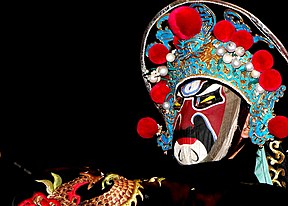User:Aza24/The arts
- A tambourine player at a traditional debaa dance festival in Mayotte
- Still Life with Profile of Laval by Paul Gauguin, 1886
- The title page of Shakespeare's sonnets in a 1609 edition by Thomas Thorpe
- Las Lajas Shrine, Nariño Department, Colombia
- A Bian Lianperformer.
The arts are a wide range of human practices which use
Lorem ipsum dolor sit amet, consectetur adipiscing elit, sed do eiusmod tempor incididunt ut labore et dolore magna aliqua. Ut enim ad minim veniam, quis nostrud exercitation ullamco laboris nisi ut aliquip ex ea commodo consequat. Duis aute irure dolor in reprehenderit in voluptate velit esse cillum dolore eu fugiat nulla pariatur. Excepteur sint occaecat cupidatat non proident, sunt in culpa qui officia deserunt mollit anim id est laborum.
Lorem ipsum dolor sit amet, consectetur adipiscing elit, sed do eiusmod tempor incididunt ut labore et dolore magna aliqua. Ut enim ad minim veniam, quis nostrud exercitation ullamco laboris nisi ut aliquip ex ea commodo consequat. Duis aute irure dolor in reprehenderit in voluptate velit esse cillum dolore eu fugiat nulla pariatur. Excepteur sint occaecat cupidatat non proident, sunt in culpa qui officia deserunt mollit anim id est laborum.
Terminology
The arts are a broad range of
Since the arts is a
Although, the 1911 Encyclopædia Britannica defined them as five practices: architecture, sculpture, painting, music and poetry, but they have [10]
[craft] Craft sometimes comes under the guise of decorative arts specifically Fariello|p=18 https://www.google.com/books/edition/Objects_and_Meaning/7YShOpQEuygC?hl=en&gbpv=1&bsq=%22art%20and%20craft%22
[fine arts] Fine arts
https://www.jstor.org/stable/546447 (liberal arts)
History
The arts are typically considered as having emerged in the
Like the prehistoric period, the arts of the ancient world were closely connected to each other, and usually produced or performed for a specific commission or event.[26] Artists or performers were usually of low status and considered craftsman, who often had no need to strive for particular originality.[26]
Because of their practical motivations [considered low status etc] or "an artisan rather than an artist" as described by Martindale [27] artisan also: https://archive.org/details/artascultureintr0000hatc/page/242/mode/2up?view=theater
medieval (p. 58) https://archive.org/details/aestheticsstudyo00feib/page/58/mode/2up?view=theater&q=%22the+arts%22
ren https://archive.org/details/artistictheoryin0000blun/page/48/mode/2up?view=theater
modern propoganda https://www.jstor.org/stable/850880?seq=2
Conceptual history
Function
"The arts occur overwhelmingly in contexts of group assembly and deal with issues of collective importance. In traditional cultures... "[29]
Overview
Historiography
Periodization
The arts
Censorship
Arts critique
Refer back to
"Rather, the recorded history of the arts reveals that far from being divorced from political, religious, and economic concerns, they have long been intimately interconnected. Vested with the explicit responsibility in many countries for cultivating the arts, and educating young and old alike in the arts, arts educators" – https://www.jstor.org/stable/pdf/10.2979 (p. 16)
Evolutionary change https://archive.org/details/artascultureintr0000hatc/page/168/mode/2up?view=theater
References
Notes
- ^ The arts scholar Ellen Dissanayake has specified these categorizes as: art as objects, art as a "quality of beauty", art as an "indicator of craftsmanship or creativity" and art as a "process of performance".[5] In a a longer list, the philosopher of art Denis Dutton variously classifies it as "direct pleasure", "skill and virtuosity", "style", "novelty and creativity", "criticism", "representation", "special focus", "expressive individuality", "emotional saturation", "intellectual challenge", "traditions and institutions", "imaginative experience".[6]
- OED Online explains that "The unmodified mass noun [art] is normally understood as referring to the visual arts; however, it may sometimes to extended to include music, literature, dance, drama, etc., though the plural form arts is frequently used to indicate a broader range of creative activities"[8]
Citations
- ^ a b c OED, § I.7.
- ^ a b c d Britannica 2023.
- ^ a b Merriam-Webster.
- ^ Hatcher 1985, p. 241.
- ^ Brown 2021, pp. 3–4.
- ^ Dutton 2009, pp. 52–59.
- ^ a b OED, § I.7, I.8a.
- ^ OED, § I.8a.
- ^ 1951, p. 497.
- ^ a b Brown 2021, p. 3.
- ^ Clowney 2011, p. 309.
- ^ a b Fancourt 2017, p. 3.
- ^ a b c Morriss-Kay 2009, § "How, when and where was art first created?".
- ^ Morley 2013, pp. 38–39.
- ^ Fancourt 2017, pp. 3–4.
- ^ Brumm et al. 2020.
- ^ Ferreira 2021.
- ^ Conard 2009, p. 248.
- ^ Wilford 2009.
- ^ Morley 2013, pp. 42–43.
- ^ Black et al. 2006, pp. 275, 325.
- ^ Fancourt 2017, p. 5.
- ^ Pastoors et al. 2021.
- ^ Fancourt 2017, pp. 4–6.
- ^ Morriss-Kay 2009, § "Shamanism and parietal art".
- ^ a b du Cros & Jolliffe 2014, p. 16.
- ^ Martindale 1990, p. 16.
- ^ Brown 2021, pp. 7–8.
- ^ Brown 2021, p. 54.
- ^ Vann 2023.
- ^ Kozbelt 2021.
- ^ Martindale 1990.
Sources
- Books
- ISBN 978-0-19-929633-0.
- Brown, Steven (2021). The Unification of the Arts: A Framework for Understanding What the Arts Share and Why. Oxford: ISBN 978-0-19-886487-5.
- ISBN 978-1-135-04141-0.
- ISBN 978-0-316-18981-1.
- ISBN 978-0-19-953942-0.
- ISBN 978-0-19-879207-9.
- Hatcher, Evelyn Payne (1985). Art As Culture: An Introduction to the Anthropology of Art. Lanham: ISBN 978-0-89789-628-3.
- Kapferer, Judith, ed. (2008). The State and the Arts: Articulating Power and Subversion. New York: ISBN 978-1-84545-578-1.
- ISBN 978-0-465-01186-5.
- Morley, Iain (2013). The Prehistory of Music: Human Evolution, Archaeology, and the Origins of Musicality. Oxford: ISBN 978-0-19-923408-0.
- Pastoors, Andreas; Lenssen-Erz, Tilman; Ciqae, Tsamgao; Kxunta, Ui; Thao, Thui; Bégouën, Robert; Uthmeier, Thorsten (2021). "Episodes of Magdalenian Hunter-Gatherers in the Upper Gallery of Tuc d'Audoubert (Ariège, France)". In Pastoors, Andreas; Lenssen-Erz, Tilman (eds.). Reading Prehistoric Human Tracks. New York: ISBN 978-3-030-60406-6.
- ISBN 978-0-593-32005-1.
- ISBN 978-0-684-31378-8.
- Shiner, Larry (2003). ISBN 978-0-226-75342-3.
- Articles
- Brumm, Adam; Oktaviana, Adhi Agus; Burhan, Basran; Hakim, Budianto; Lebe, Rustan; Zhao, Jian-Xin; Sulistyarto, Priyatno Hadi; Ririmasse, Marlon; Adhityatama, Shinatria; Sumantri, Iwan; Aubert, Maxime (1 January 2020). "Oldest cave art found in Sulawesi". Science Advances. 7 (3): eabd4648. PMID 33523879.
- Clowney, David (2011). "Definitions of Art and Fine Art's Historical Origins". JSTOR 23883666.
- Conard, Nicholas J. (2009). "A female figurine from the basal Aurignacian of Hohle Fels Cave in southwestern Germany". S2CID 205216692.
- Ferreira, Becky (13 January 2021). "Pig Painting May Be World's Oldest Cave Art Yet, Archaeologists Say - The depiction of the animal on an Indonesian island is at least 45,500 years old, the researchers say". The New York Times. Retrieved 14 January 2021.
- ISBN 978-0-19-926479-7.
- Kozbelt, Aaron (24 November 2021). "The Aesthetic Legacy of Evolution: The History of the Arts as a Window Into Human Nature". PMID 34899539.)
{{cite journal}}: CS1 maint: unflagged free DOI (link - Morriss-Kay, Gillian M (6 November 2009). "The evolution of human artistic creativity". PMID 19900185.
- Vann, Richard T. (24 March 2023). "Historiography | Definition, History, Branches, & Methodology". Encyclopædia Britannica. Chicago: Encyclopædia Britannica, Inc. Retrieved 10 July 2023.
- Wilford, John Noble (13 May 2009). "Full-Figured Statuette, 35,000 Years Old, Provides New Clues to How Art Evolved". The New York Times. Retrieved 23 October 2013.
- "The arts | Creative Expression, Visual Arts & Performing Arts". Encyclopædia Britannica. Chicago: Encyclopædia Britannica, Inc. 10 February 2023. Retrieved 10 July 2023.
- Online
- "art, n.1 meanings, etymology and more". OED Online. Oxford: Oxford University Press. Retrieved 20 July 2021.(subscription required)
- "Definition of the arts". Merriam-Webster. Archived from the original on 1 June 2017. Retrieved 14 May 2017.
Further reading
- ISBN 978-0-85772-377-2.





